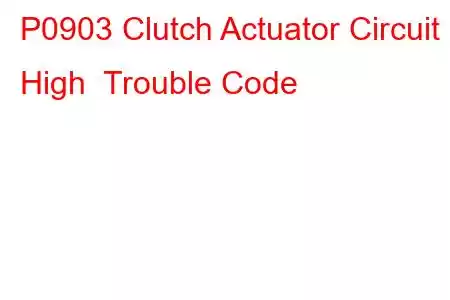P0903 Clutch Actuator Circuit High
OBD-II Trouble Code Technical Description
Clutch Actuator Circuit High
What does that mean?
This is a generic powertrain diagnostic trouble code (DTC) and applies to many OBD-II vehicles (1996-newer). That may include but is not limited to vehicles from Toyota, Smart, Ford, Mazda, Hyundai, Mercedes, etc. Although generic, the exact repair steps may vary depending on year, make, model and powertrain configuration.
OBD-II trouble code P0903 and related codes P0900, P0901, and P0903 are associated with the clutch actuator electrical circuit. This circuit is monitored by the Engine Control Module (ECM), the Power Control Module (PCM) or the Transmission Control Module (TCM) based on the specific vehicle.
The purpose of the clutch actuator circuit is to engage and disengage the clutch or clutches on a semi-automatic transmission. Based on the specific vehicle and the configuration, several sensors and associated components are required to accomplish this task. Some configurations incorporate two hydraulic clutches, one for even gears and another for odd gears. The number of gears may range from 6 to 9 on newer vehicles. Basically, this design facilitates gear changes that are smooth and seamless operating in the same manner as a fully automatic transmission.
When the ECM, PCM or TCM detects a high voltage or resistance condition in the clutch actuator circuit, code P0903 will be set and the check engine light or the transmission warning lamp will be illuminated.
A clutch actuator:
What is the severity of this DTC?
The severity of this code is normally moderate, but P0903 can be severe if the vehicle is not shifting properly that may cause damage to internal transmission components.
What are some of the symptoms of the code?
Symptoms of a P0903 trouble code may include:
Motor may not crank over Engine may stall while driving Transmission may be placed into a limp mode Transmission may be stuck in one gear Transmission warning lamp illuminated Check engine light illuminatedWhat are some of the common causes of the code?
Causes for this P0903 code may include:
Defective clutch actuator Defective sensor or solenoid Faulty or damaged wiring Loose or defective control module ground strap Corroded, damaged or loose connector Defective fuse or fuse-able link (If applicable) Clutch master cylinder malfunction Defective ECM, PCM or TCMWhat are some P0903 troubleshooting steps?
The first step in the troubleshooting process for any malfunction is to research the Technical Service Bulletins (TSB's) for the specific vehicle by year, model and power plant. In some circumstances, this can save a lot of time in the long run by pointing you in the right direction.
The second step is to locate all of components associated with the clutch actuator circuit and look for obvious physical damage. Perform a thorough visual inspection to check the associated wiring for obvious defects such as scraping, rubbing, bare wires, or burn spots. Next is to check the connectors and connections for security, corrosion and damaged pins. This process must include all wiring connectors and connections to all sensors, solenoids, actuators and control modules. Consult the specific tech data for the vehicle to see if a fuse or fuse-able link is incorporated into the circuit.
Advanced Steps
The advanced steps become very vehicle specific and require the appropriate advanced equipment to perform accurately. These procedures require a digital multi meter and the specific technical references for the vehicle. Specific technical data will include troubleshooting charts and the appropriate sequence to follow assisting you with an accurate diagnosis.
Voltage Checks
Voltage checks must be performed utilizing the specific troubleshooting guidelines for the
Read: 22


